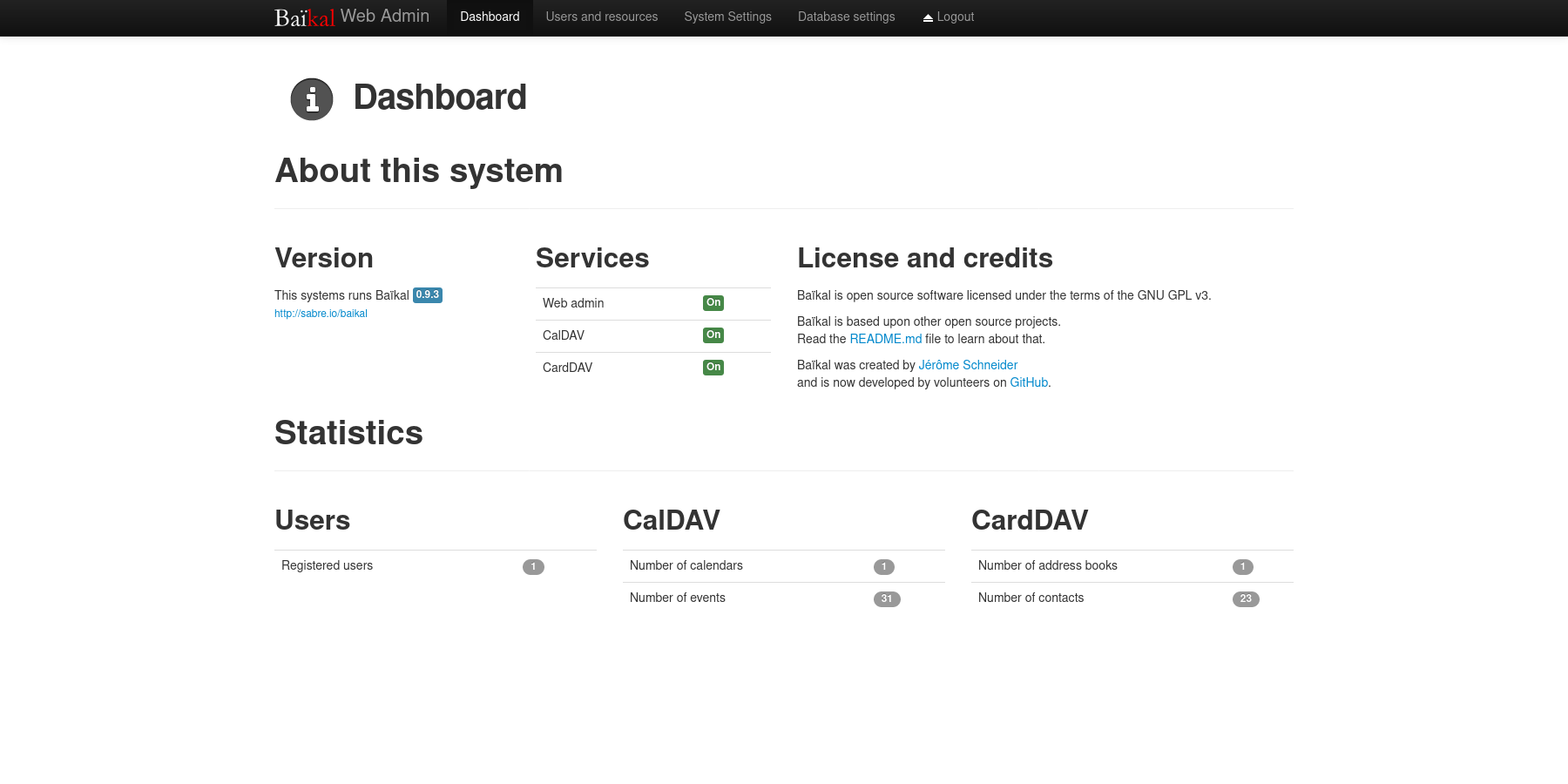1
2
3
4
5
6
7
8
9
10
11
12
13
14
15
16
17
18
19
20
21
22
23
24
25
26
27
28
29
30
31
32
33
34
35
36
37
38
39
40
41
42
43
44
45
46
47
48
49
50
51
52
53
54
55
56
57
58
59
60
61
62
63
64
65
66
67
68
69
70
71
72
73
74
75
76
77
78
79
80
81
82
83
84
85
86
87
88
89
90
91
92
93
94
95
96
97
98
99
100
101
102
103
104
105
106
107
108
109
110
111
112
113
114
115
116
117
118
119
120
121
122
123
124
125
126
127
128
129
130
131
132
133
134
135
136
137
138
139
140
141
142
143
144
145
146
147
148
149
150
151
152
153
154
155
156
|
+++
date = 2023-06-08
title = "Self-Hosting Baikal Server (CalDAV & CardDAV)"
description = ""
draft = false
+++
# What is Baikal?
[Baikal](https://sabre.io/baikal/) is a lightweight CalDAV + CardDAV server that
you can self-host on your own machine. While I have tried (& failed) to get this
CalDAV + CardDAV server running before, it was quite easy this time. Not really
sure what I did differently this time, but I'm documenting my process here to
ensure I don't forget.
# Installation
First, create a folder on your server and open a `docker-compose.yml` file for
editing:
```sh
mkdir baikal && cd baikal
nano docker-compose.yml
```
Within this file, you'll need to paste the information below. You can customize
the `ports` section to use any port on your server to pass through to port 80 in
the container. You can also edit the `volumes` section to use docker volumes
instead of local folders.
``` conf
version: "2"
services:
baikal:
image: ckulka/baikal:nginx
restart: always
ports:
- "8567:80"
volumes:
- ./config:/var/www/baikal/config
- ./data:/var/www/baikal/Specific
```
Once finished with editing, save and close the file. Then, launch the docker
container:
```sh
sudo docker-compose up -d
```
# Intial Setup
As long as no issues came up when starting the container, you should be able to
visit the server's set-up page at `http://<server_ip>:<port>`. The application
will ask you to create an administrator account and choose the database type for
your storage. Personally, I opted to use SQLite.
Make sure the administrator credentials are adequate to protect against common
attacks.
# Creating Users
Once you've set up the application, you will be greeted by the Dashboard page,
which will show the version of the app, status of the admin/CalDAV/CardDAV
services, and the number of users, calendars, events, address books, and
contacts.

To create a new user, navigate to the `Users and resources` page. This process
is as simple as entering a username, password, and email.
Once a user has been created, you can create any number of calendars and address
books for user, as well as inspect their information.
# Setting Up a Public URL
Once your application is working locally, you can open access remotely via a URL
by using a reverse-proxy like Nginx.
As a prerequisite, you must own a domain name and set up DNS records to point a
domain name to the server hosting Baikal.
Start by navigating to your web server's configuration directory and create a
new file for this application.
```sh
cd /etc/nginx/sites-available/
nano dav
```
Within this file, paste in the configuration from below and change
`dav.example.com` to match the URL you'll be using.
``` conf
server {
if ($host ~ ^[^.]+\.example\.com$) {
return 301 https://$host$request_uri;
}
listen [::]:80;
listen 80;
server_name dav.example.com;
return 404;
}
server {
listen [::]:443 ssl http2;
listen 443 ssl http2;
server_name dav.example.com;
access_log /var/log/nginx/dav.access.log;
error_log /var/log/nginx/dav.error.log;
location / {
proxy_http_version 1.1;
proxy_pass http://localhost:8567;
proxy_set_header Host $host;
}
ssl_certificate /etc/letsencrypt/live/example.com/fullchain.pem;
ssl_certificate_key /etc/letsencrypt/live/example.com/privkey.pem;
include /etc/letsencrypt/options-ssl-nginx.conf;
ssl_dhparam /etc/letsencrypt/ssl-dhparams.pem;
}
```
For Nginx on Ubuntu, you'll need to symlink the configuration file to the
`sites-enabled` directory and then restart Nginx.
```sh
sudo ln -s /etc/nginx/sites-available/dav /etc/nginx/sites-enabled/dav
sudo systemctl restart nginx.service
```
At this point, the Baikal server should be available over the internet at the
URL configured above!
# Configuring Clients
Lastly, configuring clients and applications is essential to making sure the DAV
server is being fully utilized.
You can also use the `Users and resources` page to inspect a user's personal
link to their calendars and address books by clicking the info (i) button. It
will show a URI like `/dav.php/calendars/your-user/default/`.
However, I found that the following URL works for most applications:
`/dav.php/principals/your-user/`.
I used the `principals` URL above for Thunderbird (calendar, tasks, and
contacts), as well as iOS (calendar, tasks, and contacts) and everything works
flawlessly so far.
Syncing is quick between the server and clients, and I haven't seen any
disruptions in the service or data integrity.
|
